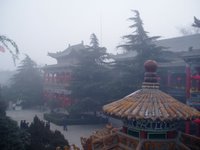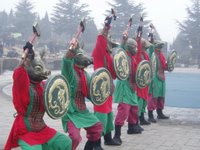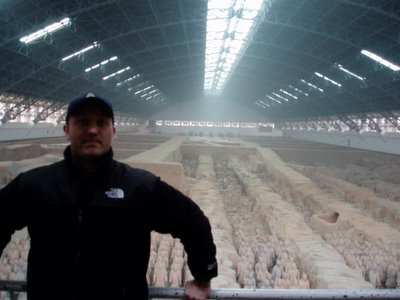Qin & The Family Stone
Saturday, the equivalent of New Year's Eve, we jumped on a bus and headed out to tour the sites east of Xi'An. Joining us was a pair of Spaniards, father and son, and some Chinese. The bus had two guides, one who spoke English just for us, but I spent as much time as I could practicing my Chinese with him.
 Anywho, first stop was the museum that purchased the first terra-cotta warriors. The story goes that in 1974, while digging a well, four farmers struck clay gold and pulled up four life-sized figures. Not knowing what the statues were, the farmers dragged them down the road to a local museum that purchased all four warriors for 28RMB (about $4). From there, its recent history.
Anywho, first stop was the museum that purchased the first terra-cotta warriors. The story goes that in 1974, while digging a well, four farmers struck clay gold and pulled up four life-sized figures. Not knowing what the statues were, the farmers dragged them down the road to a local museum that purchased all four warriors for 28RMB (about $4). From there, its recent history.More interesting than the warriors, at least at this museum, was a display holding the crystalized remains of the Buddha which were housed in a smal silver coffin itself housed in a slightly large gold coffin. I couldn't get a picture as it was behind two layers of glass, but it was the sort of artifact that Indiana Jones movies are made about.
 Next up was a small mountain, notable for two military coups:
Next up was a small mountain, notable for two military coups: 1. Long long ago China was reigned by a dynasty named the Zhou. The Zhou, who ruled from Xi'An, used this mountain to light beacon fires when help was needed in defending the nation from foreign hordes. Well, apparently one empress was a prudish little sourpuss and refused to smile. So stoic was she, that even upon receiving some of the most illustrious of visitors and their wonderful gifts she wouldn't eek a smirk. The guests were furious and the next time the beacon fire was lit, they stayed at home in spite and the Zhou dynasty fell, or better said, was forced to relocate. Thus divides the Western and Eastern Zhou Dynasties.
2. Not so long ago China was divided between the Nationalists and the Communists. Meanwhile, Japan was busy invading China. All Chinese knew they needed to unite to defeat the Japanese, but neither side would capitulate to the other and spent more time fighting each other instead of against the true, Japanese enemy. Well, long story short, the Communists eventually got the Nationalists and their leader Chiang KaiShek (a brutal Romanization of his name, Jiang JieShi) on the run and ol' KaiShek took to hiding in this here mountain. The Commies eventually found him though and forced him to unite his army with theirs. I big monument to the Party stands now at the foot of Chiang's craggy hiding spot, where one may ascend to take a picture or spit.
We kept stepping back into history and soon found ourselves in a recreation of QinShiHuang's (that first emperor guy) underground mausoleum. Now, the actual mausoleum has yet to be excavated and may never be, as the Chinese would never want to destroy the treasure within nor might they want to know the truth. Qin ShiHuang is a bit like the Holy Grail for the Chinese, their Jesus, and we're not gonna besmirch his legacy any time soon. But the recreation itself is awe-inspiring. A huge model of the original gounds is set out to view, giving you an idea of just how magnificent this guy's funeral must have been. His grave alone would be about half the size of the Forbidden City: an epic burial mound in the center surrounded by palaces and underground armies. Alas, all but the tomb suffered destruction under the hands of angry peasants thousands of years ago, but this tourist trap is still cool. One of my favorite facts; the coffin of QinShiHuang is laid out over a recreation of the world, or at least as he knew it at the time, and the detail is immense. But the really interesting part is that all the water was represented by flowing mercury. So much mercury, in fact, the ground is still contaminated to this very day. Imperial eco-terrorism. One way to leave your mark, eh?
 After the reconstruction, we visited the actual tomb. As mentioned, its nothing more than a big hill now, but we did get to take in a ceremonial offering to the big guy, including a dance of the 12 animals of the Chinese Zodiac. (Go monkey!)
After the reconstruction, we visited the actual tomb. As mentioned, its nothing more than a big hill now, but we did get to take in a ceremonial offering to the big guy, including a dance of the 12 animals of the Chinese Zodiac. (Go monkey!) With the pre-game over, time came for the big show: the terra-cotta warriors. Again, this was China's New Year's Eve, Christmas Eve, Easter, and Arbor Day all rolled into one, meaning that the Terra-Cotta Warriors Museum was as busy as metal-pole licking stand in coldest January. It was awesome. No lines, not hordes, no noise, it was as if I wasn't in China for the day. Even most of the crap-hawkers had taken off for the holiday, though the onese left behind were still wuite persistant and annoying.
Before actually taking in the digs we were treated to a movie: "The Eighth Wonder of the World." Obviously dated, the film gave the viewer a brief history of QinShiHuang, the construction of the warriors and mausoleum, and their subsequent destruction. While at first description you're probably thinking of scratchy '70s educational films ("Hi, I'm Troy McLure!), and you should, there is one last detail: THE FILM WAS DISPLAYED IN 360 DEGREES! I've never seena gimmick like this before, but it was one hell of a gimmick, even if it did leave me dizzy as I kept spinning in circles trying to take it all in.
 Then came the pits. Wow. I can't describe just how huge these things are. As it stands, there are only 3 digs open and many more untouched. Pit 1 is the largest, and its one of the largest single rooms I've ever been in. The ranks of soldiers go on and on and on, and the vast majority is still under the earth! The first pit, the largest again, holds mostly common rank and file soldiers, foot soldiers, maybe a few chariots. Pit 2 gives us more leadership, generals and such, distinguished by their taller stature. Pit 3 has even more chariots and a good amount of archers.
Then came the pits. Wow. I can't describe just how huge these things are. As it stands, there are only 3 digs open and many more untouched. Pit 1 is the largest, and its one of the largest single rooms I've ever been in. The ranks of soldiers go on and on and on, and the vast majority is still under the earth! The first pit, the largest again, holds mostly common rank and file soldiers, foot soldiers, maybe a few chariots. Pit 2 gives us more leadership, generals and such, distinguished by their taller stature. Pit 3 has even more chariots and a good amount of archers. Now apparently these warriors all had been painted, and when first unearthed still retained thier color for about three days before detriorating. Also, not a single warrior has been unearthed complete, and the archaeologists have not always been spot-on in rebuilding them. If you pay attention, you'll find warriors with two left hands, mismatched limbs, and chariot drivers sitting in the back seat of their chariots. All the more reason why the Chinese are holding off on any future excavation until technology develops.
Now apparently these warriors all had been painted, and when first unearthed still retained thier color for about three days before detriorating. Also, not a single warrior has been unearthed complete, and the archaeologists have not always been spot-on in rebuilding them. If you pay attention, you'll find warriors with two left hands, mismatched limbs, and chariot drivers sitting in the back seat of their chariots. All the more reason why the Chinese are holding off on any future excavation until technology develops.After all the touring and history, the day came to an end and we bused back to the city for a quick rest. Being Spring Festival, we wanted to feast on the traditional Spring Festival dish of dumplings, and pounded the streets looking for an otherwise omnipresent Chinese delight. However, even as early as 6 PM, even in a city of 7 million, not a single Chinese restaurant was open. Forced upon us, as the only option: Pizza Hut. I felt quite embarrassed, even a little gross (I don't like Pizza Hut anywhere, anytime). This was like eating, well, Pork Lo Mein on Thanksgiving. Luckily the staff (visibly unhappy to be working) just passed us off as silly foreigners.
Which we were.

Hey, who's that handsome devil leading an uncountable army of clay warriors?

0 Comments:
Post a Comment
<< Home